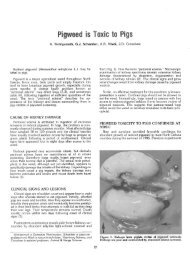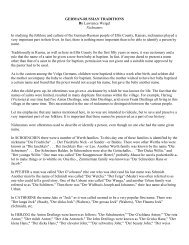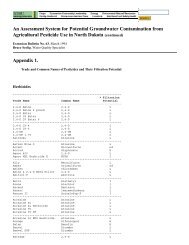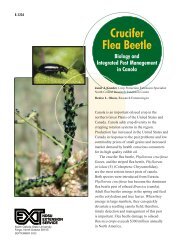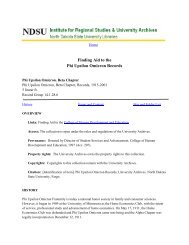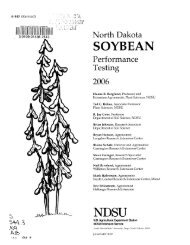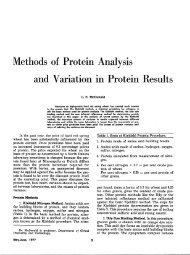germans from russia in fort collins, 1900-2000 - Libraries
germans from russia in fort collins, 1900-2000 - Libraries
germans from russia in fort collins, 1900-2000 - Libraries
You also want an ePaper? Increase the reach of your titles
YUMPU automatically turns print PDFs into web optimized ePapers that Google loves.
WORK RENDERS LIFE SWEET: GERMANS FROM RUSSIA IN FORT COLLINS<br />
Germans <strong>from</strong> Russia – at least <strong>in</strong> their spirituality<br />
– as ethnically German. 68<br />
Architecturally, both of the orig<strong>in</strong>al<br />
German-Russian churches exhibited Gothic<br />
<strong>in</strong>fluences – an important connection to and<br />
statement of German heritage. Both structures<br />
were also visible manifestation of each<br />
congregation’s particular Protestant dogma.<br />
The older of the structures, the German<br />
Evangelical Congregational Church, was<br />
completed <strong>in</strong> 1904 on the southwest corner of<br />
Olive and Whedbee Streets. It was a squareplan<br />
structure with pressed-brick walls and a<br />
red sandstone foundation and surrounds. A<br />
fifty-foot tower emerged on the northeast corner<br />
of the structure. Most notable were the<br />
large, po<strong>in</strong>ted-arch, sta<strong>in</strong>ed-glass w<strong>in</strong>dows<br />
fac<strong>in</strong>g Whedbee and Oak. Rather than seat<strong>in</strong>g<br />
worshippers <strong>in</strong> a long nave, the church conta<strong>in</strong>ed<br />
a bowled auditorium with semi-circular<br />
tiers of seat<strong>in</strong>g, better suited to<br />
Congregational services. Bethlehem<br />
Evangelical Lutheran Church, on the other<br />
hand, was oriented along a central nave<br />
flanked by narrow, sta<strong>in</strong>ed-glass w<strong>in</strong>dows<br />
between the buttresses. Despite be<strong>in</strong>g labeled<br />
as “severely Gothic” <strong>in</strong> contemporary newspaper<br />
accounts, this church was more Gothic<br />
<strong>in</strong> form than style. Arches were rounded<br />
rather than po<strong>in</strong>ted, provid<strong>in</strong>g the structure<br />
with a Romanesque flavor. Particularly <strong>in</strong>terest<strong>in</strong>g<br />
was the wooden belfry capp<strong>in</strong>g the<br />
tower. It featured rounded arches with simulated<br />
keystones, pilasters, and a protrud<strong>in</strong>g<br />
pediment. This textbook example of classical-revival<br />
architecture suggested the<br />
reawaken<strong>in</strong>g of <strong>in</strong>terest <strong>in</strong> Roman and Greek<br />
culture that accompanied the Protestant<br />
Reformation <strong>in</strong> Europe – the Renaissance.<br />
Belfries of this type were common to<br />
Lutheran churches and were particularly<br />
prom<strong>in</strong>ent on the churches at the center of<br />
German villages <strong>in</strong> the Volga region. Thus,<br />
while Bethlehem Evangelical Lutheran<br />
Church was <strong>in</strong>itially a visual conundrum –<br />
mix<strong>in</strong>g Gothic and Classical elements – it<br />
was best understood as a clear statement of<br />
German heritage mixed with Lutheran<br />
Protestantism. 69<br />
Churches hosted the most important ceremonies<br />
<strong>in</strong> the life of a German <strong>from</strong> Russia.<br />
Christen<strong>in</strong>g dedicated a child to Christ and<br />
welcomed him or her <strong>in</strong>to the German-<br />
Russian community. Confirmation signified a<br />
transition <strong>from</strong> youth to adulthood. And<br />
funerals called the community together to<br />
mourn, to remember, and to assist griev<strong>in</strong>g<br />
families. But the most elaborate and joyous<br />
ceremonies revolved around Hochzeit – “high<br />
time” or “wedd<strong>in</strong>g time” – three-day festivals<br />
celebrat<strong>in</strong>g the creation of a new family and<br />
household. Englische and German Russians<br />
alike marveled at the colorful affairs, which<br />
became a legendary part of German-Russian<br />
culture. In addition, Hochzeit was a rare<br />
moment when German-Russian families<br />
could leave beh<strong>in</strong>d the toil of the beet field<br />
and revel <strong>in</strong> their rich culture. Local historian<br />
Arlene Ahlbrandt offers this description of<br />
the 1930 wedd<strong>in</strong>g of Leah Rommel and John<br />
Fabricius: 70<br />
After the ceremony, the couple<br />
were paraded through town <strong>in</strong> a gaily<br />
decorated car; then about 15 autos followed<br />
them [to] the Fabricius farm.<br />
There a sumptuous chicken d<strong>in</strong>ner with<br />
homemade noodles, butter-ball soup, rye<br />
bread and cake was served to over 200<br />
guests.<br />
Follow<strong>in</strong>g the d<strong>in</strong>ner a dance,<br />
“Dutch Hop” was held <strong>in</strong> the hay loft of<br />
the barn. It had been cleaned, heated and<br />
decorated with lights for the happy occasion.<br />
The bride wore her wedd<strong>in</strong>g gown<br />
dur<strong>in</strong>g the afternoon but changed to a<br />
p<strong>in</strong>k georgette dress for the dance that<br />
even<strong>in</strong>g. The first dance was the<br />
groom’s dance. The next dances were<br />
the bride’s dances, and everyone who<br />
danced with her p<strong>in</strong>ned dollars to her<br />
dress. 71<br />
SWCA Environmental Consultants Page 20



